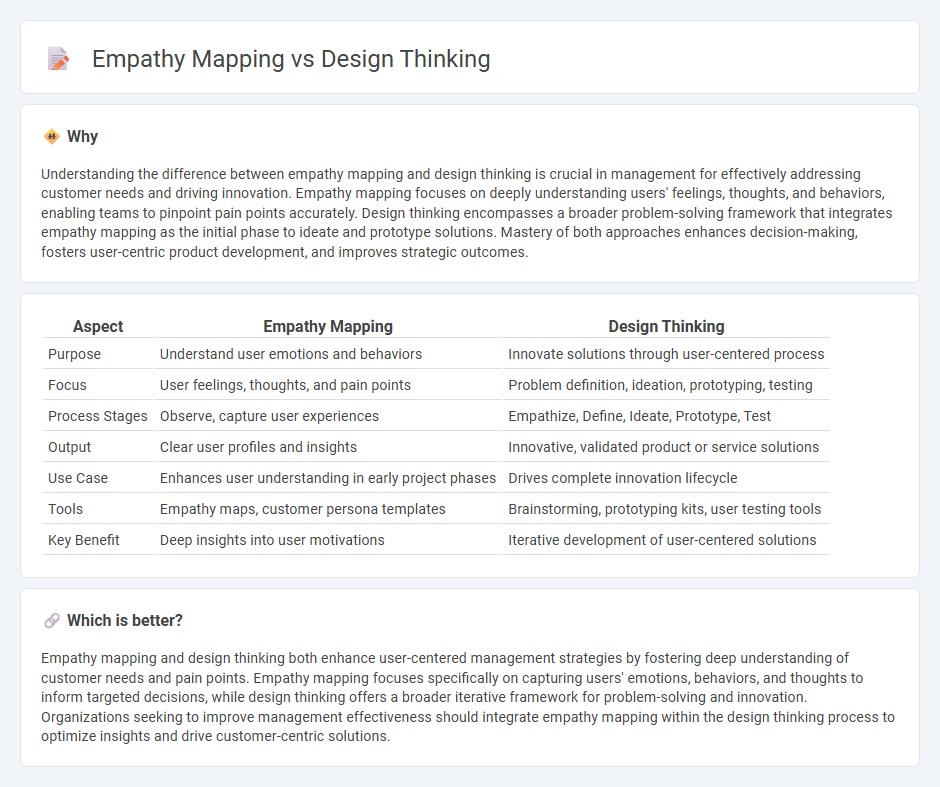
Empathy mapping focuses on understanding users' emotions, thoughts, and behaviors to create a detailed user persona, while design thinking emphasizes a solution-oriented, iterative process to address user needs through ideation and prototyping. Both methodologies enhance product development by fostering user-centric innovation and collaboration within teams. Explore deeper insights into how empathy mapping and design thinking transform management strategies and drive successful project outcomes.
Why it is important
Understanding the difference between empathy mapping and design thinking is crucial in management for effectively addressing customer needs and driving innovation. Empathy mapping focuses on deeply understanding users' feelings, thoughts, and behaviors, enabling teams to pinpoint pain points accurately. Design thinking encompasses a broader problem-solving framework that integrates empathy mapping as the initial phase to ideate and prototype solutions. Mastery of both approaches enhances decision-making, fosters user-centric product development, and improves strategic outcomes.
Comparison Table
| Aspect | Empathy Mapping | Design Thinking |
|---|---|---|
| Purpose | Understand user emotions and behaviors | Innovate solutions through user-centered process |
| Focus | User feelings, thoughts, and pain points | Problem definition, ideation, prototyping, testing |
| Process Stages | Observe, capture user experiences | Empathize, Define, Ideate, Prototype, Test |
| Output | Clear user profiles and insights | Innovative, validated product or service solutions |
| Use Case | Enhances user understanding in early project phases | Drives complete innovation lifecycle |
| Tools | Empathy maps, customer persona templates | Brainstorming, prototyping kits, user testing tools |
| Key Benefit | Deep insights into user motivations | Iterative development of user-centered solutions |
Which is better?
Empathy mapping and design thinking both enhance user-centered management strategies by fostering deep understanding of customer needs and pain points. Empathy mapping focuses specifically on capturing users' emotions, behaviors, and thoughts to inform targeted decisions, while design thinking offers a broader iterative framework for problem-solving and innovation. Organizations seeking to improve management effectiveness should integrate empathy mapping within the design thinking process to optimize insights and drive customer-centric solutions.
Connection
Empathy mapping enhances design thinking by providing deep insights into users' emotions, thoughts, and behaviors, enabling more user-centered solutions. This connection fosters innovative problem-solving through a thorough understanding of user needs and pain points. Integrating empathy mapping into design thinking accelerates effective product development and strategic decision-making in management.
Key Terms
**Design Thinking:**
Design Thinking emphasizes a user-centered approach to problem-solving through iterative phases of empathizing, defining, ideating, prototyping, and testing, aiming to create innovative solutions that meet real user needs. It integrates empathy mapping as one of its tools to deeply understand users' feelings, thoughts, and pain points during the empathize stage. Explore more about how leveraging Design Thinking transforms product development and user experience strategies.
Ideation
Design thinking centers on ideation by fostering creative problem-solving through iterative brainstorming and prototyping to generate innovative solutions. Empathy mapping emphasizes understanding user emotions, behaviors, and needs to inform ideation with deep user insights, ensuring solutions are user-centric. Explore how combining design thinking and empathy mapping can enhance your ideation process for breakthrough innovations.
Prototyping
Design thinking's prototyping phase emphasizes rapid creation of tangible solutions to test and refine ideas, enabling iterative user feedback integration. Empathy mapping complements this by providing deep insights into user feelings, thoughts, and pain points, which guide the development of more user-centered prototypes. Explore how combining these approaches enhances innovation and user experience refinement.
Source and External Links
What is Design Thinking? -- updated 2025 | IxDF - Design thinking is a non-linear, iterative process involving five phases--Empathize, Define, Ideate, Prototype, and Test--that helps teams understand users, challenge assumptions, and create innovative solutions, starting with desirability before feasibility and viability.
The 5 Stages in the Design Thinking Process | IxDF - It is a human-centered, iterative methodology used to solve complex, ill-defined problems through five key steps: Empathize, Define, Ideate, Prototype, and Test, enabling problem reframing and creative solution development.
What is Design Thinking & Why Is It Beneficial? - IDEO U - Design thinking centers on human needs and combines empathy, creativity, and iterative prototyping to generate impactful solutions that balance desirability, feasibility, viability, and ethical responsibility.
 dowidth.com
dowidth.com